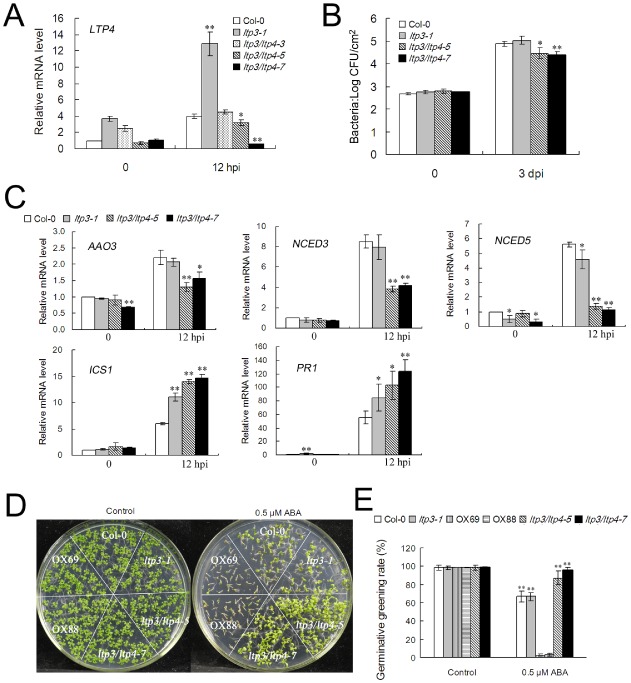Figure 6.

Double mutant ltp3/ltp4 is more resistant to P seudomonas syringae pv. tomato (P st) DC3000 and insensitive to abscisic acid (ABA) (A) LTP4 transcript levels in different double mutants ltp3/ltp4 were determined by quantitative reverse transcription‐polymerase chain reaction (RT‐PCR) Plants were challenged with P st DC3000 [5 × 106 colony‐forming units (CFU)/mL]. The data represent the means of three replicates ± standard deviation (SD). Significant differences from the wild‐type are denoted by one or two asterisks, corresponding to P < 0.05 and P < 0.01, respectively, by Student's test. hpi, hours post‐inoculation. (B) ltp3/ltp4 was more resistant to P st DC3000 than the wild‐type. In planta bacterial growth was determined at 3 days post‐inoculation (dpi) at a cell density of 2 × 105 CFU/mL. Data shown are the means of three biological replicates ± SD. Significant differences from the wild‐type are denoted by one or two asterisks, corresponding to P < 0.05 and P < 0.01, respectively, by Student's test. At least three independent experiments were performed with similar results. (C) The expression levels of AAO3, NCED3, NCED5, ICS1 and PR1 were determined by quantitative RT‐PCR at 12 hpi with P st DC3000 (5 × 106 CFU/mL). The data represent the means of three replicates ± SD. Significant differences from the wild‐type are denoted by one or two asterisks, corresponding to P < 0.05 and P < 0.01, respectively, by Student's test. (D, E) Insensitivity of ltp3/ltp4 to ABA in seed germination. (D) Photographs were taken 9 days after stratification. (E) Germination rate was scored 7 days after stratification. Data are means of three independent experiments ± SD (each with at least 100 seeds for each line). Significant differences from the wild‐type are denoted by two asterisks, corresponding to P < 0.01, by Student's test.
